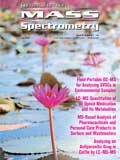Review of the 64th Conference on Mass Spectrometry and Allied Topics
Special Issues
We present a brief review of this year's ASMS conference, which took place June 5–9 in San Antonio, Texas.
We present a brief review of this year’s ASMS conference, which took place June 5–9, 2016, in San Antonio, Texas.
The 64th Conference on Mass Spectrometry and Allied Topics took place June 5–9 in San Antonio, Texas, at the Henry B. González Convention Center. Short courses preceded the conference opening, starting Saturday, June 4, and continuing through Sunday, June 5.
Opening the conference program on Sunday were tutorial sessions and a plenary lecture. The first tutorial, by Facundo Fernandez of the Georgia Institute of Technology (Atlanta, Georgia), and Glen Jackson of West Virginia University (Morgantown, West Virginia), was titled “Forensic Mass Spectrometry: Tell Me Something I Don’t Know.” Lars Konermann of the University of Western Ontario (London, Ontario, Canada) followed Fernandez and Jackson with a tutorial titled “An Analyte’s Journey from Solution into the Gas Phase.”
ASMS Vice President for Programs Vicki H. Wysocki of the Ohio State University (Columbus, Ohio) officially welcomed attendees. She was followed by Erica Ollmann Saphire of the Scripps Institute (La Jolla, California), who gave the plenary lecture, titled “A Molecular Arsenal Against Ebola.” After Saphire’s talk, a welcome reception took place in the poster and exhibit hall.
Three more plenary events took place during the week, two of which were award lectures, given by Scott A. McLuckey on Monday, and by Kristina Håkansson on Tuesday (details below). On Thursday, William Bialek of Princeton University (Princeton, New Jersey) gave a plenary lecture titled “More than the Sum of its Parts: Collective Phenomena in Living Systems, from Single Molecules to Flocks of Birds.”
Continuing in the tradition of previous ASMS conferences, oral sessions, poster sessions, and exhibits took place throughout the day, Monday through Thursday, and workshops took place daily, Monday through Thursday.
Awards
This year’s conference included several award presentations. The 2016 Award for a Distinguished Contribution in Mass Spectrometry was presented on Monday afternoon to Scott A. McLuckey of Purdue University (West Lafayette, Indiana) for his pioneering contributions to the understanding of the gas-phase ion–ion reactions of polyatomic molecules and their applications in analytical mass spectrometry. McLuckey and his coworkers initiated and sustained a line of research employing electrospray and ion traps that has revealed a wide and expanding array of ion-ion reactions that significantly expand the scope of tandem mass spectrometry, particularly in biological mass spectrometry.
Kristina “Kicki” Håkansson of the University of Michigan (Ann Arbor, Michigan) was presented with the 2016 Biemann Medal on Tuesday afternoon for her work in developing and elucidating the mechanisms of electron-based activation methods, including electron capture dissociation, electron detachment dissociation, and electron induced dissociation. She has applied these electron-based activation methods to identify and characterize biological molecules from a number of classes, including peptides, oligonucleotides, and oligosaccharides.
Also presented on Tuesday afternoon were the 2016 Research Awards, funded by Thermo Fisher Scientific and Waters Corporation, in the amount of $35,000 each. This year’s awardees were Ronghu Wu of Georgia Institute of Technology, and Etienne Garand of the University of Wisconsin-Madison.
The 2016 Ron A. Hites Award for an outstanding research publication in
The Journal of the American Society for Mass Spectrometry (JASMS) was presented on Wednesday afternoon to Kevin Pagel, of the Max Planck Society in Berlin, Germany, and coauthors Waldemar Hoffmann and Johanna Hofmann for their paper “Energy-Resolved Ion Mobility-Mass Spectrometry: A Concept to Improve the Separation of Isomeric Carbohydrates.” The award recognizes an outstanding publication of original research, based on a paper’s innovative aspects, technical and presentation quality, likely stimulation of future research, and impact on future applications. The award is named in honor of Professor Ron Hites of Indiana University, who led the creation of JASMS in 1988 while he was president of ASMS. The award includes $2,000 and a certificate for each author.
Also presented on Wednesday afternoon were the 2016 Postdoctoral Awards. Four awards in the amount of $10,000 each went to John Cahill of the Oak Ridge National Laboratory, Andrew DeBlase of Purdue University, Catherine Going of Stanford University, and Pengyuan Liu of The Wistar Institute. The awards are intended to promote the professional career development of postdoctoral fellows in the field of mass spectrometry. Activities funded by these awards include conference and workshop attendance, travel to other mass spectrometry laboratories, and the purchase of books and software.
A closing event took place Thursday evening at the Briscoe Western Art Museum. The museum was named in honor of the late Texas Governor, Dolph Briscoe, Jr. His wife, Janey, preserves and interprets the art, history, and culture of the American West though engaging exhibitions, education programs, and public events reflective of the region’s rich traditions and shared heritage.
ASMS 2017
The 65th Annual ASMS Conference will be held June 4–8, 2017, in Indianapolis, Indiana. For more information, visit www.asms.org in the coming months.
Cindy Delonas is the Associate Editor for Spectroscopy. Direct correspondence to: cdelonas@advanstar.com

New Study Reviews Chromatography Methods for Flavonoid Analysis
April 21st 2025Flavonoids are widely used metabolites that carry out various functions in different industries, such as food and cosmetics. Detecting, separating, and quantifying them in fruit species can be a complicated process.

.png&w=3840&q=75)

.png&w=3840&q=75)



.png&w=3840&q=75)



.png&w=3840&q=75)











